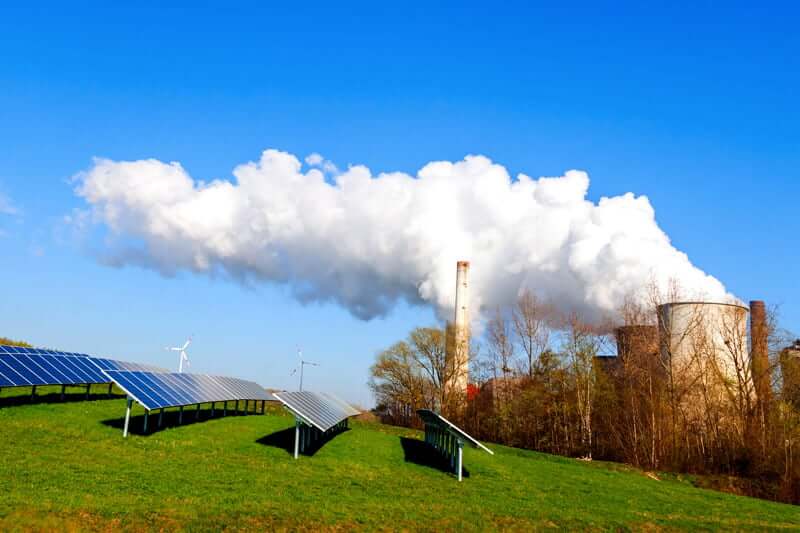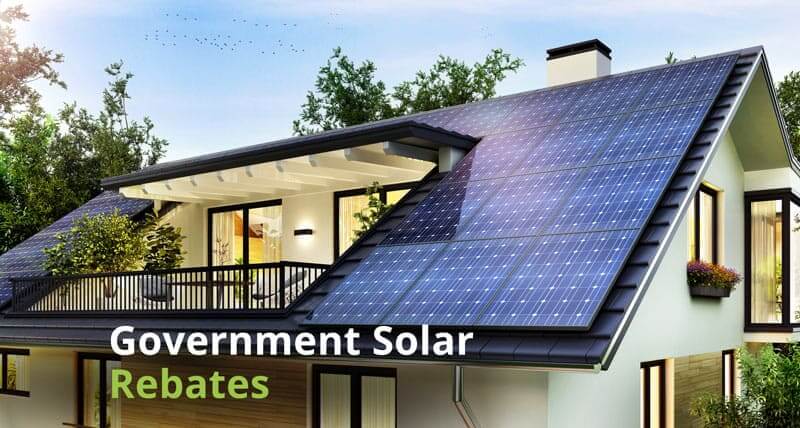Home How Much Does Solar Energy Reduce Carbon Footprint?
How Much Does Solar Energy Reduce Carbon Footprint?
Choosing to use solar energy for lighting up your home or business cuts down on your part in the issue of carbon emissions – basically, it’s your own bit of the responsibility for sending greenhouse gases and other noxious compounds into the air. Since solar energy is renewable and doesn’t harm our planet, more folks are starting to embrace it. Yet, it does bring up a point of discussion: is switching to solar a big step towards reducing your environmental footprint?
Solar energy emits carbon, but it can reduce the overall emission level by as much as 80%. But you must understand the carbon footprint of the electricity grid and other sources before calculating how much a solar power system reduces the carbon footprint.

Table of Contents
ToggleGreenhouse gas and carbon footprint
A carbon footprint is the greenhouse gas emission caused by a person or a group of persons. How they contribute depends on lifestyle; movements, use of natural gas, and other methods. One way or another, everyone has a carbon footprint, and it affects the climate change happening worldwide.
A greenhouse gas is a type that holds heat trapped in the atmosphere, and carbon dioxide is only one such gas. Carbon dioxide enters the atmosphere through different means but burning fossil fuels. Fossil fuels can be oil, coal, or natural gas, and each one has a certain level of carbon emissions for which it is responsible.
Due to the nature of conventional electricity production, it tends to emit a high amount of carbon per year. But switching to solar energy may significantly reduce the number.
How solar energy reduces the carbon footprint
To understand how much a solar power system reduces carbon footprint, you must know the average carbon output from the electricity grid. Let us use a 6KW solar system as an example for better understanding.
The daily electricity production from a 6kW solar system is 24kWh on average. This amounts to 8,760kWh on average per year.
The electricity grid emits about 600 grams of carbon equivalent per kWh, according to the Australian power sector as of 2020. Using this figure, you can determine how much carbon a 6KW solar power system offsets per year of regular usage:
Multiply the yearly kWh output of the solar system with the estimated carbon output from the electricity grid, which is 8760 x 600 = 5,256,000 grams. Converted to kilograms = 5,256 kg. So, a typical 6KW solar system offsets about 5,256 kg of carbon per year if the system is at maximum output.
Note: These numbers are estimations and can be higher or lower depending on the grid size, solar system, and electricity usage. You will have to find the exact figures in grams for yearly carbon emissions in your locality plus the yearly energy generation from a solar system to get specific figures.
What is the carbon footprint of a solar power system?
Before you can determine the effect of solar energy in offsetting the carbon footprint, you must consider its contribution to carbon emissions. While the carbon footprint of solar panels is quite small, the manufacturing and production processes for a typical solar system play a significant role in carbon emissions.
Therefore, let us look at how solar energy contributes to the overall carbon footprint in the atmosphere.

Solar panel type
Access to solar energy means using solar panels or solar radiation concentrating mirrors. Since solar panels are the more popular option today, you must consider the type in use and its production process.
Several types of solar panels fill the market, but the most popular ones are made from silicon due to their energy efficiency.
Monocrystalline solar panels
Monocrystalline solar panels are the most efficient today and are made from single-silicon crystals. However, their production process involves a lot of energy, which translates to significant carbon emissions.
Polycrystalline solar panels
Polycrystalline panels also need some energy to melt silicon crystals together. However, they do not need as much as monocrystalline cells, so they do not emit as much carbon. Other types of solar panels are not as efficient as the silicon types but the process of making them does not require high energy.
Lifespan
While looking at how the type of panels used affects carbon emissions, it is also important to consider the disposal of old panels. A typical solar panel lasts about 25 years, but it can pay its carbon debt back in about three of those years. That means it produces clean, carbon-free energy for the rest of its life.
However, old panels have to be discarded at some point. Apart from the old ones, consider prematurely-replaced solar panels. Users tend to replace solar systems prematurely to benefit from government incentives. Contractors also typically replace entire systems when there is a problem with only one panel. Consequently, there is an abundance of used panels.
Recycling may work, but there are currently only a few solar panel recycling plants in Australia. In other words, transporting used panels long distances produces carbon that the panels can no longer offset.
Manufacturing
There are different stages of manufacturing components of a solar system. Apart from the panels, which are the primary components, you must also consider the inverter, without which the system cannot convert energy to usable electricity.
If you are using home storage, a battery is also essential, and it involves a different production method.
First, there is the extraction of raw materials for the various components. There is an abundance of silicon for the solar panels, but it needs to be moved from the mining site to the factories, which means burning gas.
Also, the process of melting it in a furnace at scorching temperatures requires burning coal, and coal emits about 18 times more carbon than solar energy. Using natural gas may still account for 13 times more carbon emissions than solar energy.
Environmental impact
Solar energy produces little to no carbon emissions during use. It emits about 50 grams of carbon per kilowatt-hour (kWh) of electricity it produces.
So, the amount of energy in kWh produced by a solar power system per day will determine how much that system helps to reduce its carbon footprint.
However, this number only accounts for when solar energy is in use. There are other processes that go before arriving at the final step of using any solar power system, and these processes contribute to the carbon footprint of a solar system.
In other words, knowing how much carbon the production of a solar system emits determines how much carbon footprint it offsets in its lifespan.
Mining raw materials for the components of a solar system means people and other living things in those areas will be affected. Some may have to move away because of road or building construction, depending on the magnitude of the mining operation. In addition, burning fossil fuels is mandatory for such an operation and moving the materials to different manufacturing plants.
Environmental benefits
While solar production plays a minor role in carbon emissions into the atmosphere, its pros far outweigh its cons. One advantage of using solar energy is that you offset its carbon debt within a short period. Another is that it positively affects how much you pay for electricity.
Other possible benefits of using solar energy apart from carbon footprint reduction are:
Mitigation of climate change
Carbon emissions contribute to global warming. You will notice the effects of the change in climate by how much the sea level rises, the acidification of the ocean, higher temperatures, and the change in precipitation patterns.
The size of the solar power system in use determines how much carbon footprint it can reduce. Nevertheless, solar energy makes a difference in climate change, regardless of size. As more people switch to solar from conventional electricity, there will be a noticeable change in these effects resulting from climate change.
Job opportunities
There was not much in the way of job opportunities in the solar power industry when it was not very popular. However, as more people become aware of the benefits of solar energy, there is a need for more contractors, components, systems, and installers.
In other words, the solar industry has created a lot of job opportunities in a few short years.
As with everything else worth mentioning, solar energy is becoming more advanced, with newer technologies emerging now and then.
And with more to do in the industry, there are always more opportunities. Therefore, there is always room for more people to find jobs, even in the field of training and making more professionals in the solar business.
Electricity independence
With more solar systems becoming available over the years, countries are becoming less dependent on conventional energy sources. Any country able to produce large amounts of solar power has some independence from its national grid.
That means fewer carbon emissions and more clean energy. Even countries depending on foreign help for electricity production can become self-reliant and even improve revenue through solar energy production.
One of the upsides of using clean energy such as solar is that you can feed excess generated energy to the grid. That way, other users can buy clean energy at reduced rates, further lowering the use of conventional electricity and greenhouse gas emissions.
Better air quality
A lack of emissions into the atmosphere leaves the air better for breathing, not just for humans but also for plants and animals. The more homes use solar energy, the better the air quality as there will be fewer greenhouse gas emissions.
Reducing your carbon footprint with solar energy
Installing a solar system on your property is just one step in reducing emissions. You must also have an adequate solar system size and a proper installation. The larger the system, the more energy it can produce. And the more there is to store or feed into the grid, the more clean energy there is for people to use.
If you are still connected to the grid, which many solar system users are, you do not have to worry about seamless switching between the two suppliers.
However, it is also crucial to position the panels in such a way that they receive the best supply of sunlight and avoid shading. The same is true for off-grid systems, except that they do not have any carbon footprint from using conventional electricity.
The panels need proper orientation; most panels perform best when facing the north because of the sun. But sometimes, a solar system is best when the panels face east or west, based on the peak energy usage time in the home and location.
Energy usage
The ideal time to use electricity in any home is during the day. This is when most people perform tasks that cause carbon emissions, so you can pull your weight by not contributing to the number.
However, if you are not home most of the day, you can time heavy-duty appliances such as refrigerators and air conditioners to work in your absence.
It also helps if you have a storage system such as a battery for excess generated power. Using a battery with your solar system instead of feeding excess power to the grid ensures you do not use conventional electricity, regardless of the amount. That way, you further cut down your carbon footprint.
Consider cutting down the energy usage in your home: take shorter showers, use less hot water when possible, turn off lights when not in use, and use energy-saving appliances. In other words, do not use electricity when it is not necessary.
Maintaining the solar power system
Monitoring the solar system is one way to ensure you make the most out of it. Over time, solar panels get dirty, and dirt acts as insulation. A significant amount of dirt on the panels reduces their sunlight-trapping capacity, effectively reducing how much energy they can generate.
Therefore, clean the panels from time to time. There are cleaning kits for solar panels, and your contractors can offer various options. You can also use the services of professional cleaners with experience with solar panels for the task. Another option is to install an automatic cleaning system that works like a sprinkler system.
Table of Contents
Toggle




